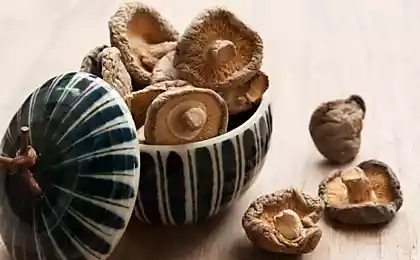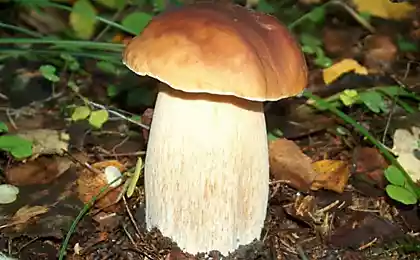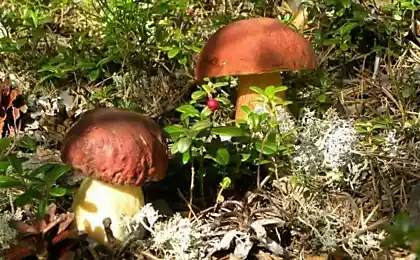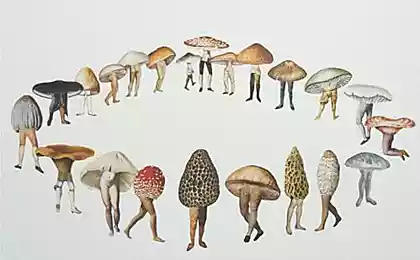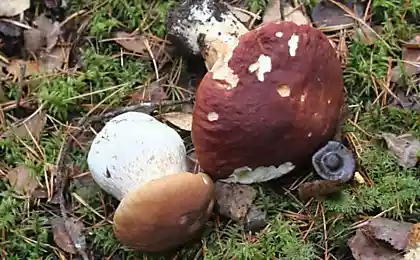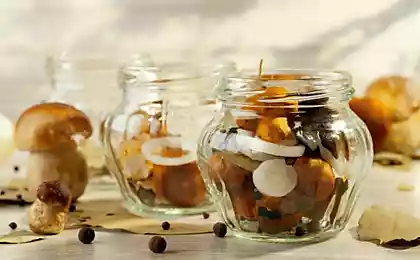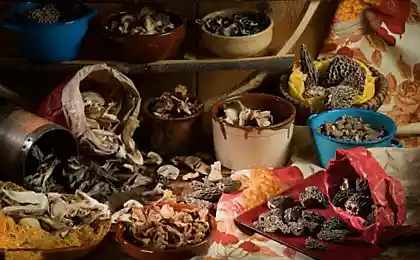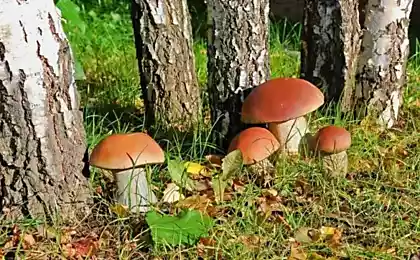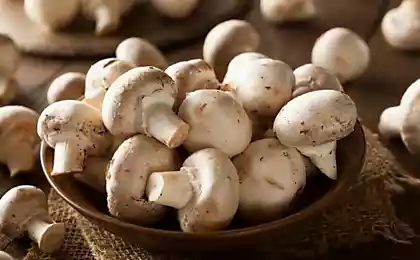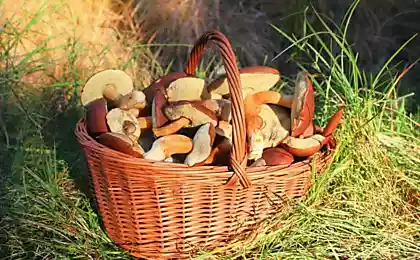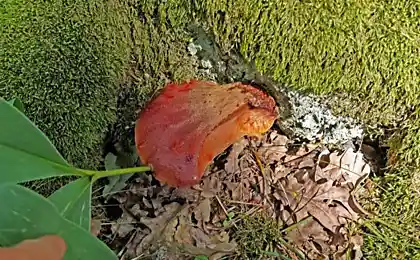891
Mushroom energy: the biggest mystery
What do they think of mushrooms?
In 2000, the year Professor Toshiyuki Nakagaki, a biologist and a physicist from the University of Hokkaido, took a sample of yellow fungi and placed it at the entrance to the maze, which is used to test the intelligence and memory of mice. At the other end of the maze he placed a sugar cube.
Physarum polycephalum like the smell of sugar and began to send its sprouts on his quest. Webs of fungus was split in two at each junction of the maze, and those that have hit a dead end, turned around and started to look in other directions. Within a few hours the mushroom webs filled the aisles of the maze, and the end of the day one of them found their way to the sugar.
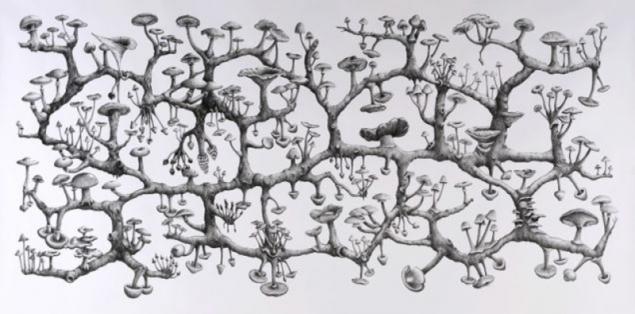
After that, Toshiyuki and his group of researchers took a piece of spider web fungus, which participated in the first experiment and placed it at the entrance of the copy of the same dungeon, also with a sugar cube at the other end. What happened amazed everyone.
In the first second of the web was divided into two: one arm made its way to the sugar, without a single extra turn, the other climbed up the wall of the maze and crossed it directly at the ceiling, straight to the goal. Mushroom cobweb not only remember the road, but it also changed the rules of the game.
I dared to resist the tendency to treat these creatures like plants. When you are engaged in research of mushrooms for several years, you begin to pay attention to two things. First, mushrooms are closer to animal life than it seems. Secondly, their actions sometimes look like the result of a conscious decision. I thought that the mushrooms should give you the opportunity to try to solve the riddles...
— Toshiyuki Nakagaki
Further studies of Toshiyuki found that fungi can plan transportation routes is no worse and much faster than the engineering professionals. Toshiyuki took a map of Japan and put pieces of food in places corresponding to the major cities of the country. The mushrooms he put "Tokyo". After 23 hours they constructed a linear network of webs to all the pieces of food. The result is almost an exact copy of the rail network around Tokyo.
Not too difficult to connect a few dozen points; but to connect them effectively and most economically – it is not easy. I believe that our research not only help to understand how to improve the infrastructure, but also how to build more efficient networks. – Toshiyuki Nakagaki
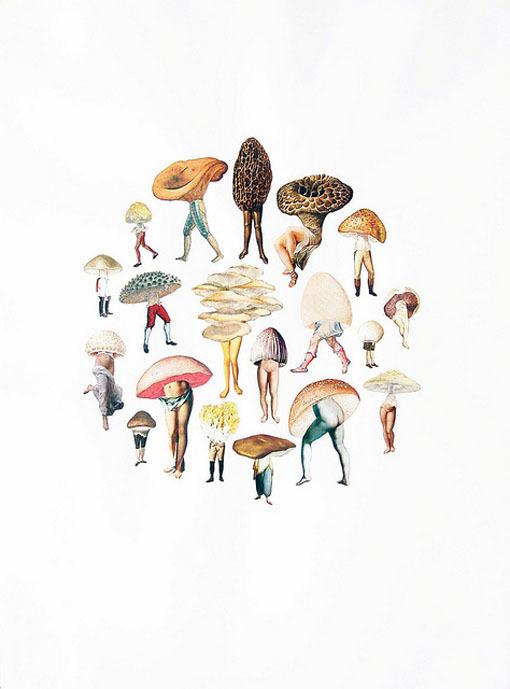
THE MYSTERY OF ANOTHER BEING
Only at a conservative estimate, on Earth there are about 160 thousand strains of fungi, most of which have impressive powers.
For example, in Chernobyl was discovered mushroom-eating radioactive products and, at the same time, purifying the air around him. This fungus was found on the wall of the destroyed nuclear power plant, which for many years after the disaster continued to produce the radiation destroys all life within a radius of several kilometers.
Exploring the Amazon forest, two biology students from Yale University found a fungus, Pestalotiopsis microspora, is able to decompose plastic. This ability was discovered when the fungus ate a Petri dish in which it was grown.
So far, neither our science or our technology is not capable of it. The plastic pollution is one of the biggest technological problems. Today, we're excited about this fungus.
— Professor Scott A. Strobl
Geneticists from the American Institute of Bioenergy managed to ensure that the strain of fungi quickly digest the natural sugar xylose. The potential importance of this discovery lies in the creation of new, cheap and quick way of producing clean bio-fuel.
It would seem, how "primitive" organism that has no brain and limited in movement, works miracles beyond science?
To try to understand the world of the fungus, it is necessary first to explain something. Shiitake, Portobello and champignon is not only the names of edible mushrooms. Each of them is a living organism that represents the network of the millions of subtle webs under the earth. Peeking out of the land of the mushrooms – this is just the "fingertips" of these webs, "tools" through which the body distributes its seeds. In each "finger" contains thousands of spores. They spread the wind and animals. When the spores get into the ground, then create a new network, and grow new mushrooms.
This creature breathes oxygen. It is so unusual from a biological point of view, it belongs to its own Kingdom separate from animals and from plants.
But what do we really know about this form of life?
We don't know what motivates the underground system of webs at a certain point to release the mushrooms on the surface of the earth; why a single mushroom growing in the side of one tree and the other to the other; and why some of them produce deadly poisons, and other delicious, healthy and flavorful. In some cases we can't even predict the timeline of their development. Mushrooms can appear in three years, and may cross 30 years after their dispute found a suitable tree. In other words, we don't know about mushrooms, even the most basic things. — Michael Pollan, a researcher.
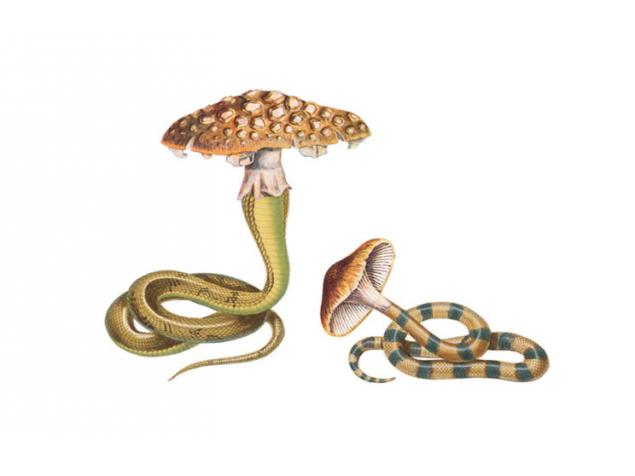
QUEEN OF THE DEAD
It is difficult for us to understand the mushroom due to their anatomical structure. When you take in hand a tomato, you hold in your hand the whole tomatoes as it is. But you can't disrupt the fungus and to investigate its structure. The mushroom is just the fruit of a large and complex organism. The network of webs is too thin, so it can be cleaned from the ground without damaging. — Segula, Macpi, a microbiologist.
Another issue is that most wild mushrooms are impossible to domesticate, and very difficult to grow, like research and industrial purposes.
They only choose a certain litter, decide when to germinate. Often their choice falls on old trees that cannot be moved to another location. And even if we land in the forest hundreds of suitable trees and will spray the earth billions of spores, there will be no guarantee to produce mushrooms within a reasonable time. — Michael Pollan, a researcher.
System food, growth, reproduction and energy production in fungi are completely different than animals. They have no chlorophyll and so, unlike plants, they do not directly use energy from the sun. Mushrooms, shiitake and Portobello, for example, grow on a bed of wilted plants.
Like animals, fungi digest food, but, unlike them, digest food outside their bodies: fungi secrete enzymes that decompose organic matter into its components and then absorb these molecules.
If the soil is the stomach of the globe, mushrooms are his digestive juices. Without their ability to decompose and recycle organic matter, earth would have long ago suffocated. Dead matter would accumulate indefinitely, the carbon cycle is interrupted, and all would be left alive without food.
In our studies, we focusareas on the life and growth in nature but no less important is the death and decay. Mushrooms are the undisputed rulers of the Kingdom of death. Therefore, by the way, so many of them in cemeteries. But the biggest mystery is the huge energy mushroom. There are mushrooms that are able to crack asphalt, glow in the dark, process for the night a whole bunch of petrochemical waste and turn it into edible and nutritious food. Mushroom Coprinopsis atramentaria capable of a few hours to grow a fruiting body and then, one day, turn into a puddle of black ink.
Magic mushrooms change the minds of people. There are poisonous mushrooms that can kill an elephant. And the paradox is that they all contain a tiny amount of calories, with which researchers usually measure energy. Our method has the dimension of energy apparently does not fit here. Calories characterize the solar energy stored in plants. But mushrooms are only weakly linked to the sun. They grow in the night and wither in the afternoon. Their energy is something else entirely.
— Michael Pollan, a researcher.
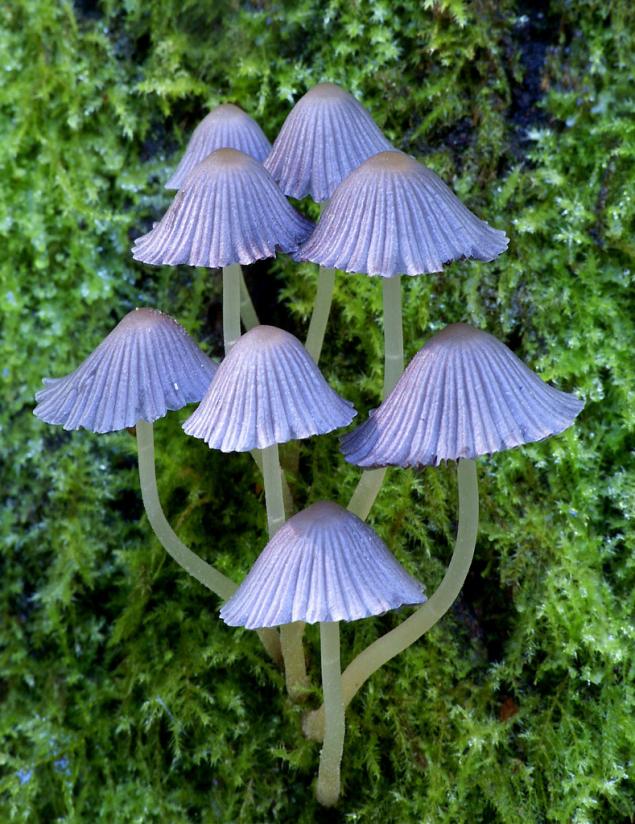
THE INTERNET UNDERGROUND
The mycelium is a complex infrastructure which includes all plants in the world. Ten cubic centimeters of soil can be found eight kilometers of its webs. Foot man covers about half a million kilometers of closely spaced webs. — Paul Stamets, mycologist.
What happens in those webs?
In the early 1990-ies the idea that the network of these webs is not only food and chemicals, but is smart and self-learning network. Considering even small areas of the network, is easy to recognize the familiar structure. Graphic representation of the Internet look exactly the same.
Network of branches, if one branch fails, it is replaced quickly detours. Its nodes are located in strategic areas better supplied with food at the expense of less active sites, and become larger. These webs have a sensitivity. And each spider can transmit information across the network.
And there is no "Central server". Each gossamer independent, and it collects the information can be transmitted to the network in all directions. Thus, the basic model of the Internet has existed in all times, only hid it in the ground.
— Paul Stamets, mycologist
The network itself is, it seems, can grow to infinity. For example, in Michigan has been found the mycelium that has grown under the ground at the area of nine square kilometers. Is estimated that its age is about 2000 years.
When the network decides to grow mushrooms?
Sometimes the reason is a danger for the future of the network. If the forest supply network, is burned, the mycelium stops receiving sugars from the tree roots. Then she proresive the mushrooms in the most remote their ends so they spread fungal spores, "released" her genes and gave them the opportunity to find a new place. So came the expression "mushrooms after rain". The rain washes away the earth of organic rot and, in effect, deprives the network of the source of its power — then the network and sends a "rescue teams" with spores in search of a new refuge.
A NIGHTMARE FOR INSECTS
"Finding a new home" is another thing that distinguishes fungi from the Kingdom of animals and plants. There are mushrooms that spread their spores like fruit to spread their seeds. Others produce pheromones that encourage living beings to their obsessive craving. The white truffle gatherers use to search for pigs, as the smell of these mushrooms smell like alpha-boar.
However, there are more sophisticated and cruel ways of spreading fungi. Observation of West African ants of the species Megaloponera foetens stated that they annually climb the tall trees, and with such force strikes its jaws in the trunk, which is then unable to escape and die. Earlier cases of mass suicide of ants was not observed.
It turned out that the insects are against her will, and someone else sends them to their deaths. The reason – the tiny spores of the fungus הטומנטלה, which sometimes you can fall into the mouths of ants. Being in the head of an insect, the dispute is sending to his brain chemicals.
After that, the ant begins to climb the nearest tree and sinks his jaws into its bark. Here, as if waking from a nightmare, he begins to try to escape and, in the end, exhausted, dies. Approximately two weeks later from his head sprout mushrooms הטומנטלה.
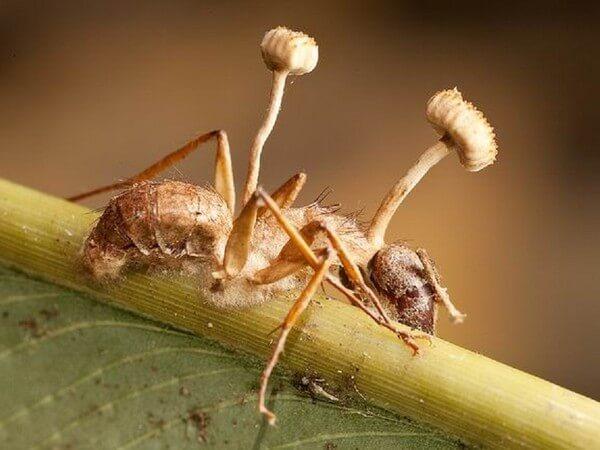
On trees in Cameroon, you can see hundreds of mushrooms growing from the bodies of ants. For mushrooms this power of the brain is the means of reproduction: they use the legs of an ant to climb a tree, and the height helps spread their spores by the wind; so they find a new home.... new ants.
Thai "zombie fungus" Ophiocordyceps unilateralis ants feeding encourages them to climb to the leaves of some plants. The distance that overcome this infected ants far exceed the distances in their ordinary life, and because, having reached the leaves, the insects die from fatigue and hunger, and two weeks later, their bodies sprouting mushrooms.
This being, perhaps, the most striking of all that I have ever seen. We believe that they produce a chemical similar to LSD but we haven't seen any drugs that cause behaviors consistent with someone's interests. — Professor David Hughes.
Hughes found mushrooms that control brain spiders, lice and flies.
It's not a coincidence, natural selection or side effects of another process. These insects are sent against their will to a place where they shouldn't be, but like mushrooms. When we moved infected ants to other leaves, the mushrooms just didn't take. — Professor David Hughes
AS INVENTED ANTIBIOTICS
The fact that fungi can produce strong poisons, there is a positive side. Some of these poisons are effective weapons against our common enemies. For example, microbes.
The best source of antibiotics in the mushrooms.
— Paul Stamets, mycologist.
160 thousand species of fungi whose bodies contain complex chemical compounds that science has been able to decode and play only 20, and among them was found a few essential drugs.
There is a reason why mushrooms make drugs. They always grow in the worst places, in damp, in heat, in places that represent the "factory of germs and viruses." Most plants have no protection from these factors, but the mushrooms – resist. Famous medicine Lipitor, which is one of the few known solutions for problems with cholesterol and diabetes, was discovered in a red Chinese mushroom. And Enoki and shiitake mushrooms included in the basket of drugs received by cancer patients in Japan. — Elinor Shavit, mikrolog.
Unfortunately, the diversity of fungal drugs is constantly decreasing. The reason is the destruction of arboreal forests, especially in the Amazon basin.
At the same time with other forms of life, we destroy and mushrooms. The number of species decreases constantly and it bothered me for purely selfish reasons. The world gave a stunning gift – a huge natural laboratory for the manufacture of drugs. From penicillin to cancer, AIDS, influenza and senile diseases. Not without reason the ancient Egyptians called mushrooms "the God of death". Today we are steadily destroying this lab...
— Paul Stamets, mycologist.
Stamets tells about the mushroom fomitopsis. This fungus, found in 1965, proved to be an effective remedy against tuberculosis, but today it grows only in five locations throughout the United States. In Europe this fungus is already completely gone.
With a group of professionals we many times went into the woods, trying to find a few more of these mushrooms. After much effort we finally found one sample that managed to grow in the laboratory. Who knows how many people will save this mushroom in the future. — Paul Stamets, mycologist.
Last year, Stamets joined the program of biological defense U.S. Department of defense and helped in the search and you save 300 rare species of fungi.
We conducted an experiment: put together four heaps of waste. One we used as a control; in the other two we added chemical and biological substances, decomposing garbage; over the latter is sprayed fungal spores.
Returning two months later, we found three dark fetid heap and one bright, overgrown with hundreds of pounds of mushrooms... Part of poisonous substances has become organic.
Mushrooms have attracted insects, those laid eggs from which hatched the caterpillars and then came the birds – and the whole lot turned into a green, full of life hill. When we tried to do the same in polluted rivers, noted the cleansing of poisons. Here's what to explore! May all of our pollution problems can be solved with suitable fungi.
— Paul Stamets, mycologist.
WHERE IS THE BRAIN?
"According to one estimate, in fungi it works the same way, says Toshiyuki, — From a purely biological point of view, each web separately receives chemical signals about where she should move and what to avoid. The sum of these signals creates a unique system of decision-making. In other words, the intelligence of the mushroom – in its network. Add to this the millions of years of evolution in the most difficult conditions, multiplied by hundreds of thousands of different kinds, and you will receive something that, in any case, should be smart enough".
And that's Your explanation?
— It's a start.published
Author: Ignat Gvozdik
P. S. And remember, just changing your mind — together we change the world! ©
Source: mayday.rocks/?p=8826
In 2000, the year Professor Toshiyuki Nakagaki, a biologist and a physicist from the University of Hokkaido, took a sample of yellow fungi and placed it at the entrance to the maze, which is used to test the intelligence and memory of mice. At the other end of the maze he placed a sugar cube.
Physarum polycephalum like the smell of sugar and began to send its sprouts on his quest. Webs of fungus was split in two at each junction of the maze, and those that have hit a dead end, turned around and started to look in other directions. Within a few hours the mushroom webs filled the aisles of the maze, and the end of the day one of them found their way to the sugar.

After that, Toshiyuki and his group of researchers took a piece of spider web fungus, which participated in the first experiment and placed it at the entrance of the copy of the same dungeon, also with a sugar cube at the other end. What happened amazed everyone.
In the first second of the web was divided into two: one arm made its way to the sugar, without a single extra turn, the other climbed up the wall of the maze and crossed it directly at the ceiling, straight to the goal. Mushroom cobweb not only remember the road, but it also changed the rules of the game.
I dared to resist the tendency to treat these creatures like plants. When you are engaged in research of mushrooms for several years, you begin to pay attention to two things. First, mushrooms are closer to animal life than it seems. Secondly, their actions sometimes look like the result of a conscious decision. I thought that the mushrooms should give you the opportunity to try to solve the riddles...
— Toshiyuki Nakagaki
Further studies of Toshiyuki found that fungi can plan transportation routes is no worse and much faster than the engineering professionals. Toshiyuki took a map of Japan and put pieces of food in places corresponding to the major cities of the country. The mushrooms he put "Tokyo". After 23 hours they constructed a linear network of webs to all the pieces of food. The result is almost an exact copy of the rail network around Tokyo.
Not too difficult to connect a few dozen points; but to connect them effectively and most economically – it is not easy. I believe that our research not only help to understand how to improve the infrastructure, but also how to build more efficient networks. – Toshiyuki Nakagaki

THE MYSTERY OF ANOTHER BEING
Only at a conservative estimate, on Earth there are about 160 thousand strains of fungi, most of which have impressive powers.
For example, in Chernobyl was discovered mushroom-eating radioactive products and, at the same time, purifying the air around him. This fungus was found on the wall of the destroyed nuclear power plant, which for many years after the disaster continued to produce the radiation destroys all life within a radius of several kilometers.
Exploring the Amazon forest, two biology students from Yale University found a fungus, Pestalotiopsis microspora, is able to decompose plastic. This ability was discovered when the fungus ate a Petri dish in which it was grown.
So far, neither our science or our technology is not capable of it. The plastic pollution is one of the biggest technological problems. Today, we're excited about this fungus.
— Professor Scott A. Strobl
Geneticists from the American Institute of Bioenergy managed to ensure that the strain of fungi quickly digest the natural sugar xylose. The potential importance of this discovery lies in the creation of new, cheap and quick way of producing clean bio-fuel.
It would seem, how "primitive" organism that has no brain and limited in movement, works miracles beyond science?
To try to understand the world of the fungus, it is necessary first to explain something. Shiitake, Portobello and champignon is not only the names of edible mushrooms. Each of them is a living organism that represents the network of the millions of subtle webs under the earth. Peeking out of the land of the mushrooms – this is just the "fingertips" of these webs, "tools" through which the body distributes its seeds. In each "finger" contains thousands of spores. They spread the wind and animals. When the spores get into the ground, then create a new network, and grow new mushrooms.
This creature breathes oxygen. It is so unusual from a biological point of view, it belongs to its own Kingdom separate from animals and from plants.
But what do we really know about this form of life?
We don't know what motivates the underground system of webs at a certain point to release the mushrooms on the surface of the earth; why a single mushroom growing in the side of one tree and the other to the other; and why some of them produce deadly poisons, and other delicious, healthy and flavorful. In some cases we can't even predict the timeline of their development. Mushrooms can appear in three years, and may cross 30 years after their dispute found a suitable tree. In other words, we don't know about mushrooms, even the most basic things. — Michael Pollan, a researcher.

QUEEN OF THE DEAD
It is difficult for us to understand the mushroom due to their anatomical structure. When you take in hand a tomato, you hold in your hand the whole tomatoes as it is. But you can't disrupt the fungus and to investigate its structure. The mushroom is just the fruit of a large and complex organism. The network of webs is too thin, so it can be cleaned from the ground without damaging. — Segula, Macpi, a microbiologist.
Another issue is that most wild mushrooms are impossible to domesticate, and very difficult to grow, like research and industrial purposes.
They only choose a certain litter, decide when to germinate. Often their choice falls on old trees that cannot be moved to another location. And even if we land in the forest hundreds of suitable trees and will spray the earth billions of spores, there will be no guarantee to produce mushrooms within a reasonable time. — Michael Pollan, a researcher.
System food, growth, reproduction and energy production in fungi are completely different than animals. They have no chlorophyll and so, unlike plants, they do not directly use energy from the sun. Mushrooms, shiitake and Portobello, for example, grow on a bed of wilted plants.
Like animals, fungi digest food, but, unlike them, digest food outside their bodies: fungi secrete enzymes that decompose organic matter into its components and then absorb these molecules.
If the soil is the stomach of the globe, mushrooms are his digestive juices. Without their ability to decompose and recycle organic matter, earth would have long ago suffocated. Dead matter would accumulate indefinitely, the carbon cycle is interrupted, and all would be left alive without food.
In our studies, we focusareas on the life and growth in nature but no less important is the death and decay. Mushrooms are the undisputed rulers of the Kingdom of death. Therefore, by the way, so many of them in cemeteries. But the biggest mystery is the huge energy mushroom. There are mushrooms that are able to crack asphalt, glow in the dark, process for the night a whole bunch of petrochemical waste and turn it into edible and nutritious food. Mushroom Coprinopsis atramentaria capable of a few hours to grow a fruiting body and then, one day, turn into a puddle of black ink.
Magic mushrooms change the minds of people. There are poisonous mushrooms that can kill an elephant. And the paradox is that they all contain a tiny amount of calories, with which researchers usually measure energy. Our method has the dimension of energy apparently does not fit here. Calories characterize the solar energy stored in plants. But mushrooms are only weakly linked to the sun. They grow in the night and wither in the afternoon. Their energy is something else entirely.
— Michael Pollan, a researcher.

THE INTERNET UNDERGROUND
The mycelium is a complex infrastructure which includes all plants in the world. Ten cubic centimeters of soil can be found eight kilometers of its webs. Foot man covers about half a million kilometers of closely spaced webs. — Paul Stamets, mycologist.
What happens in those webs?
In the early 1990-ies the idea that the network of these webs is not only food and chemicals, but is smart and self-learning network. Considering even small areas of the network, is easy to recognize the familiar structure. Graphic representation of the Internet look exactly the same.
Network of branches, if one branch fails, it is replaced quickly detours. Its nodes are located in strategic areas better supplied with food at the expense of less active sites, and become larger. These webs have a sensitivity. And each spider can transmit information across the network.
And there is no "Central server". Each gossamer independent, and it collects the information can be transmitted to the network in all directions. Thus, the basic model of the Internet has existed in all times, only hid it in the ground.
— Paul Stamets, mycologist
The network itself is, it seems, can grow to infinity. For example, in Michigan has been found the mycelium that has grown under the ground at the area of nine square kilometers. Is estimated that its age is about 2000 years.
When the network decides to grow mushrooms?
Sometimes the reason is a danger for the future of the network. If the forest supply network, is burned, the mycelium stops receiving sugars from the tree roots. Then she proresive the mushrooms in the most remote their ends so they spread fungal spores, "released" her genes and gave them the opportunity to find a new place. So came the expression "mushrooms after rain". The rain washes away the earth of organic rot and, in effect, deprives the network of the source of its power — then the network and sends a "rescue teams" with spores in search of a new refuge.
A NIGHTMARE FOR INSECTS
"Finding a new home" is another thing that distinguishes fungi from the Kingdom of animals and plants. There are mushrooms that spread their spores like fruit to spread their seeds. Others produce pheromones that encourage living beings to their obsessive craving. The white truffle gatherers use to search for pigs, as the smell of these mushrooms smell like alpha-boar.
However, there are more sophisticated and cruel ways of spreading fungi. Observation of West African ants of the species Megaloponera foetens stated that they annually climb the tall trees, and with such force strikes its jaws in the trunk, which is then unable to escape and die. Earlier cases of mass suicide of ants was not observed.
It turned out that the insects are against her will, and someone else sends them to their deaths. The reason – the tiny spores of the fungus הטומנטלה, which sometimes you can fall into the mouths of ants. Being in the head of an insect, the dispute is sending to his brain chemicals.
After that, the ant begins to climb the nearest tree and sinks his jaws into its bark. Here, as if waking from a nightmare, he begins to try to escape and, in the end, exhausted, dies. Approximately two weeks later from his head sprout mushrooms הטומנטלה.

On trees in Cameroon, you can see hundreds of mushrooms growing from the bodies of ants. For mushrooms this power of the brain is the means of reproduction: they use the legs of an ant to climb a tree, and the height helps spread their spores by the wind; so they find a new home.... new ants.
Thai "zombie fungus" Ophiocordyceps unilateralis ants feeding encourages them to climb to the leaves of some plants. The distance that overcome this infected ants far exceed the distances in their ordinary life, and because, having reached the leaves, the insects die from fatigue and hunger, and two weeks later, their bodies sprouting mushrooms.
This being, perhaps, the most striking of all that I have ever seen. We believe that they produce a chemical similar to LSD but we haven't seen any drugs that cause behaviors consistent with someone's interests. — Professor David Hughes.
Hughes found mushrooms that control brain spiders, lice and flies.
It's not a coincidence, natural selection or side effects of another process. These insects are sent against their will to a place where they shouldn't be, but like mushrooms. When we moved infected ants to other leaves, the mushrooms just didn't take. — Professor David Hughes
AS INVENTED ANTIBIOTICS
The fact that fungi can produce strong poisons, there is a positive side. Some of these poisons are effective weapons against our common enemies. For example, microbes.
The best source of antibiotics in the mushrooms.
— Paul Stamets, mycologist.
160 thousand species of fungi whose bodies contain complex chemical compounds that science has been able to decode and play only 20, and among them was found a few essential drugs.
There is a reason why mushrooms make drugs. They always grow in the worst places, in damp, in heat, in places that represent the "factory of germs and viruses." Most plants have no protection from these factors, but the mushrooms – resist. Famous medicine Lipitor, which is one of the few known solutions for problems with cholesterol and diabetes, was discovered in a red Chinese mushroom. And Enoki and shiitake mushrooms included in the basket of drugs received by cancer patients in Japan. — Elinor Shavit, mikrolog.
Unfortunately, the diversity of fungal drugs is constantly decreasing. The reason is the destruction of arboreal forests, especially in the Amazon basin.
At the same time with other forms of life, we destroy and mushrooms. The number of species decreases constantly and it bothered me for purely selfish reasons. The world gave a stunning gift – a huge natural laboratory for the manufacture of drugs. From penicillin to cancer, AIDS, influenza and senile diseases. Not without reason the ancient Egyptians called mushrooms "the God of death". Today we are steadily destroying this lab...
— Paul Stamets, mycologist.
Stamets tells about the mushroom fomitopsis. This fungus, found in 1965, proved to be an effective remedy against tuberculosis, but today it grows only in five locations throughout the United States. In Europe this fungus is already completely gone.
With a group of professionals we many times went into the woods, trying to find a few more of these mushrooms. After much effort we finally found one sample that managed to grow in the laboratory. Who knows how many people will save this mushroom in the future. — Paul Stamets, mycologist.
Last year, Stamets joined the program of biological defense U.S. Department of defense and helped in the search and you save 300 rare species of fungi.
We conducted an experiment: put together four heaps of waste. One we used as a control; in the other two we added chemical and biological substances, decomposing garbage; over the latter is sprayed fungal spores.
Returning two months later, we found three dark fetid heap and one bright, overgrown with hundreds of pounds of mushrooms... Part of poisonous substances has become organic.
Mushrooms have attracted insects, those laid eggs from which hatched the caterpillars and then came the birds – and the whole lot turned into a green, full of life hill. When we tried to do the same in polluted rivers, noted the cleansing of poisons. Here's what to explore! May all of our pollution problems can be solved with suitable fungi.
— Paul Stamets, mycologist.
WHERE IS THE BRAIN?
"According to one estimate, in fungi it works the same way, says Toshiyuki, — From a purely biological point of view, each web separately receives chemical signals about where she should move and what to avoid. The sum of these signals creates a unique system of decision-making. In other words, the intelligence of the mushroom – in its network. Add to this the millions of years of evolution in the most difficult conditions, multiplied by hundreds of thousands of different kinds, and you will receive something that, in any case, should be smart enough".
And that's Your explanation?
— It's a start.published
Author: Ignat Gvozdik
P. S. And remember, just changing your mind — together we change the world! ©
Source: mayday.rocks/?p=8826
Pēteris kļava: in the next 20-40 years the Western culture will die
How to make a wooden porch with their hands
